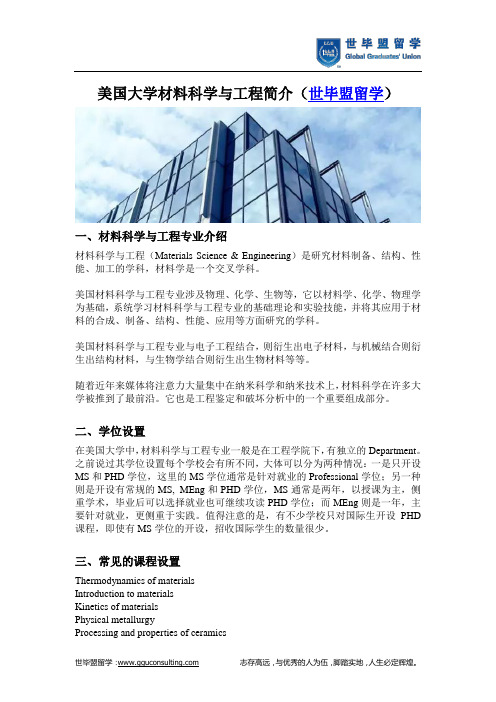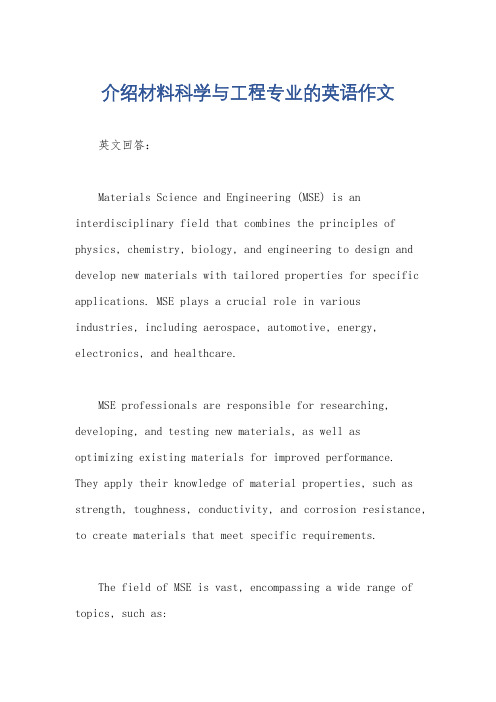材料科学与工程概述(原文)matscience
材料科学与工程概述

材料科学与工程概述
该课程的主要内容包括材料的分类、结构、性能和制备方法,以及材料在工程应用中的作用。
其中,对于材料的分类,主要包括金属、陶瓷、聚合物和复合材料等。
对于材料的结构,主要介绍原子结构、晶体结构和非晶体结构,以及结构与性能之间的关系。
在材料的性能方面,该课程主要涵盖力学性能、热学性能、电学性能、磁学性能和光学性能等。
在制备方法方面,主要介绍物理制备方法、化学制备方法、机械制备方法和生物制备方法等。
此外,该课程还介绍了材料在各种工程应用中的作用,包括航空航天、能源、电子、医疗和环保等。
在这些应用中,各种材料需要满足不同的要求,如高温、高压、高强度、高导电性和抗腐蚀等。
通过学习材料科学与工程概述,学生可以了解材料科学和工程的发展历史、基本概念和应用领域,为进一步深入学习相关课程打下坚实基础。
- 1 -。
材料科学与工程专业介绍_范文

材料科学与工程专业介绍篇一:材料科学与工程专业介绍材料科学与工程专业材料科学与工程即材料科学与工程专业。
材料科学与工程(英文名:MaterialsScienceandEngineering,缩写MSE)。
在国务院学位委员会学科评议组制定和颁布的《授予博士、硕士学位和培养研究生的学科、专业目录》中,材料科学与工程属于工学学科门类之中的其中一个一级学科,下设3个二级学科,分别是:材料物理与化学、材料学、材料加工工程。
材料科学与工程专业是研究材料成分、结构、加工工艺与其性能和应用的学科。
在现代科学技术中,材料科学是国民经济发展的三大支柱之一。
主要专业方向有金属材料、无机非金属材料、耐磨材料、表面强化、材料加工等。
1专业特色材料科学与工程专业以材料学、化学、物理学为基础,系统学习材料科学与工程专业的基础理论和实验技能,并将其应用于材料的合成、制备、结构、性能、应用等方面研究的学科。
2培养目标材料科学与工程专业培养具备包括金属材料、无机非金属材料、高分子材料等材料领域的科学与工程方面较宽的基础知识,能在各种材料的制备、加工成型、材料结构与性能等领域从事科学研究与教学、技术开发、工艺和设备设计、技术改造及经营管理等方面工作,适应社会主义市场经济发展的高层次、材料科学研究者高素质全面发展的科学研究与工程技术人才。
培养要求材料科学与工程专业学生主要学习材料科学与工程的基础理论,学习与掌握材料的制备、组成、组织结构与性能之间关系的基本规律。
受到金属材料、无机非金属材料、高分子材料、复合材料以及各种先进材料的制备、性能分析与检测技能的基本训练。
掌握材料设计和制备工艺设计、提高材料的性能和产品的质量、开发分析与检测技能的基本训练。
掌握材料设计和制备工艺设计、提高材料的性能和产品的质量、开发研究新材料和新工艺方面的基本能力。
[2]3知识领域1.掌握金属材料、无机非金属材料、高分子材料、防腐专业以及其它高新技术材料科学的基础理论和材料合成与制备、材料复合、材料设计等专业基础知识;2.掌握材料性能检测和产品质量控制的基本知识,具有研究和开发新材料、新工艺的初步能力;3.掌握材料加工的基本知识,具有正确选择设备进行材料研究、材料设计、材料研制的初步能力;4.具有本专业必需的机械设计、电工与电子技术、计算机应用的基本知识和技能;5.熟悉技术经济管理知识;6.掌握文献检索、资料查询的基本方法,具有初步的科学研究和实际工作能力。
材料科学与工程专业介绍

材料科学与工程专业介绍材料科学与工程是一门综合性较强的学科,它研究的是材料的结构、性能、制备和应用等方面。
随着科技的发展,材料科学与工程的地位越来越重要,具有广阔的发展前景和良好的就业前景。
材料科学与工程专业主要涉及的内容包括金属材料、无机非金属材料、有机高分子材料和复合材料等。
学生在学习期间将学习材料的基本理论知识,如材料的结构与性能关系、材料的制备方法等,还将学习材料的表征和分析方法,掌握材料的测试与检测技术。
此外,学生还将学习材料的应用领域,了解材料在工程和科学领域中的应用情况,掌握材料的设计、改性和加工技术。
在学习材料科学与工程专业时,学生将接受一定的数学、物理、化学和工程基础的训练。
这些基础知识的学习将帮助学生理解和解决材料科学与工程的相关问题。
此外,学生还将接受实验操作和实习的训练,培养科学实践和工程实践的能力。
材料科学与工程专业毕业后,学生可以选择从事科学研究、工程和技术管理等多个领域的工作。
毕业生可以在材料制备、材料测试与检测、材料设计和改性等领域从事科研工作,参与材料创新和新材料的开发工作。
同时,毕业生也可以在材料工程领域从事产品开发和工程设计工作,参与新材料在工程领域的应用和推广。
材料科学与工程专业的发展前景广阔。
由于材料在现代工业和科学领域中的广泛应用,对于材料科学与工程的需求与日俱增。
随着科技的不断进步,新型材料的需求日益增长。
因此,材料科学与工程专业的毕业生将有很好的就业前景。
总之,材料科学与工程专业是一门综合性较强、有着广阔发展前景和良好就业前景的学科。
学生在学习期间将学习材料的基本理论知识和实践技能,培养科学实践和工程实践能力。
毕业后,学生可以选择从事科研、工程和技术管理等领域的工作,为材料创新和新材料的开发做出贡献。
材料科学与工程

材料科学与工程材料科学与工程是研究材料性能、结构和制备工艺的学科,涉及到材料的选择、设计和应用。
本文将从材料科学与工程的概念、研究内容、应用领域以及未来发展等方面进行探讨。
概念介绍材料科学与工程是一门跨学科的学科,涵盖了物理学、化学、工程学等多个学科的知识。
它研究的对象是材料的性能、结构和制备工艺。
通过对材料的研究,可以改善材料性能,提高产品的质量和性能。
研究内容材料科学与工程的研究内容包括:1. 材料的物理性能研究:研究材料的力学性能、电学性能、热学性能等。
2. 材料的化学性能研究:研究材料的腐蚀性能、耐热性能、抗氧化性能等。
3. 材料的结构研究:研究材料的晶体结构、微观结构和宏观结构。
4. 材料的制备工艺研究:研究制备材料的方法和工艺。
应用领域材料科学与工程在很多领域都有广泛的应用,包括但不限于以下几个方面:1. 电子领域:材料科学与工程在半导体器件、集成电路、电子显示等领域发挥着重要作用。
2. 能源领域:材料科学与工程在新能源开发、能源存储和转换等方面具有重要意义。
3. 医疗领域:材料科学与工程在医疗器械、生物医学材料等方面有广泛应用。
4. 航空航天领域:材料科学与工程对于航空航天器材料的研究和开发至关重要。
未来发展随着科学技术的不断进步和社会的不断发展,材料科学与工程在未来的发展中将会有更广阔的前景。
1. 新材料的研究与开发:随着科技的不断进步,新型材料的研究和开发成为材料科学与工程的一个重要方向。
2. 环保材料的研究与应用:面对全球环境问题,绿色环保材料的研究和应用将成为材料科学与工程的重要发展方向。
3. 材料的智能化与功能化:随着人工智能和物联网技术的发展,材料的智能化与功能化将成为未来材料科学与工程的发展趋势。
总结材料科学与工程是一门跨学科的学科,它研究材料的性能、结构和制备工艺。
在电子、能源、医疗、航空航天等领域都有广泛的应用。
未来,材料科学与工程将继续发展并面临新的挑战和机遇,为各个领域的科学技术进步和社会发展做出贡献。
材料科学与工程概述

拉伸强度、断裂韧性、疲劳强度、蜗变强度、硬度 电导率或电阻率、离子电导率、半导体电导率 磁化率、居里温度、尼尔温度、饱和磁化强度 偏振、电容、介电常数、反光指数、吸收作用 热膨胀系数、热容量、导热率偏振、电容、介电常数、 反光指数、吸收作用 腐蚀行为、磨损行为
Company Logo
准备 大学前 学ห้องสมุดไป่ตู้课程 认可课程 职业培训 关注点
Company Logo
专业机构
专业机构和协会为那些投身于材料科学与工程的人提供了广泛的规划和导航资 源。这些团体对你的发展起着关键作用,帮你了解在你的行业里正发生着什么。 更多专业协会尽在/assoc.htm.
ASM 国际: 美国陶瓷学会: 美国陶瓷学会 材料研究学会: 材料研究学会 矿物金属与材料学会: 矿物金属与材料学会 …………
实现自身价值
提高技术水平是重 要的, 要的,但发展其他 能力(如,人际交 能力( 往能力、 往能力、网络知识 学习借鉴) 、学习借鉴)同样 至关重要。 至关重要。掌握这 有机会和同行面对面讨论 些能力将更有至于 材料上的成功和突破, 材料上的成功和突破,不 实现自身价值。 实现自身价值。 仅是一个项目的成功, 仅是一个项目的成功,也 是一种个人的成功。 是一种个人的成功。共享 信息与一般想法可以互利 互惠, 互惠,这也是成功工程师 的标志。 的标志。网络是人们获取 虽然你不用再跑去教室上 新见解的最重要的资源。 新见解的最重要的资源 课了, 课了,但依然要学习专业 。 知识。 知识。继续接受教育的形 式可能有: 式可能有:阅读学术期刊 参加会议、 ,参加会议、研讨会或培 训课程和获得专业协会会 员资格。 员资格。
日常生活
制造业中的大多数任务是由跨职 能的人组成的团队完成的。 能的人组成的团队完成的。材料 工程师一般都是独立的, 工程师一般都是独立的,为了一 项工作而联合起来——从概念设 项工作而联合起来 从概念设 计到制造过程再到最终产品。 计到制造过程再到最终产品。
【精品】材料科学与工程(Materials Science and Engineering)专业英语讲义word版

材料科学与工程专业英语Materials Science and EngineeringUnit1Materials Science and EngineeringMaterials are properly more deep-seated in our culture than most of us realize. 材料可能比我们大部分人所意识到的更加深入地存在于我们的文化当中。
Transportation, housing, clothing, communication, recreation and food production-virtually every segment of our lives is influenced to one degree or another by materials.运输、住房、衣饰、通讯、娱乐,还有食品生产——实际上我们日常生活的每个部分都或多或少地受到材料的影响。
Historically, the development and advancement of societies have been int imately tied to the members’ abilities to produce and manipulate materials to fill their needs. 从历史上看,社会的发展和进步已经与社会成员生产和利用材料来满足自身需求的能力紧密地联系在一起。
In fact, early civilizations have been designated by the level of their materials development.事实上,早期文明是以当时材料的发展水平来命名的。
(也就是石器时代,青铜器时代)The earliest humans has access to only a very limited number of materials, those that occur naturally stone, wood, clay, skins, and so on. 最早的人类只能利用非常有限数量的材料,象那些自然界的石头,木头,黏土和毛皮等等。
材料科学与工程概论

材料科学与工程概论材料科学与工程是一门研究材料的性能、结构、制备和应用的学科,它涉及了广泛的领域,包括金属、陶瓷、高分子、半导体等材料类型。
作为一门跨学科的学科,材料科学与工程对于现代工业和科技的发展起着至关重要的作用。
本文将从材料科学与工程的基本概念、发展历程、研究内容和应用前景等方面进行介绍。
首先,材料科学与工程是一门研究材料的学科,它关注材料的结构、性能和制备工艺。
材料的性能包括力学性能、热学性能、电学性能、光学性能等,而材料的结构则包括原子结构、晶体结构、晶粒结构等。
通过对材料的性能和结构进行研究,可以为材料的设计、制备和应用提供理论基础和技术支持。
其次,材料科学与工程的发展历程可以追溯到古代人类利用石器、陶器和金属器的时代。
随着工业革命的到来,材料科学与工程得到了迅速发展,新材料的不断涌现推动了工业和科技的进步。
20世纪以来,材料科学与工程经历了从传统材料到功能材料、智能材料的演变,为人类社会的发展做出了重要贡献。
再次,材料科学与工程的研究内容涵盖了材料的设计、制备、表征和应用等方面。
在材料的设计和制备过程中,需要考虑材料的性能需求、工艺条件和成本控制等因素;而在材料的表征和应用过程中,则需要对材料的结构和性能进行分析和评价,以确定其适用范围和改进方向。
最后,材料科学与工程在能源、环境、医疗、信息等领域具有广泛的应用前景。
随着人类社会对新能源、清洁环境、健康医疗和智能信息的需求不断增加,新型材料的研发和应用将成为未来的重要趋势。
因此,材料科学与工程将继续发挥重要作用,推动人类社会的可持续发展。
综上所述,材料科学与工程作为一门重要的学科,对于现代工业和科技的发展具有重要意义。
它的发展历程、研究内容和应用前景都展现了其巨大的潜力和广阔的发展空间。
相信随着科技的不断进步和人类对材料需求的不断提高,材料科学与工程将迎来更加美好的未来。
材料科学与工程概论

材料科学与工程概论
材料科学与工程的研究对象包括各种自然材料(如金属、陶瓷、塑料、橡胶等)以及人工材料(如纤维、复合材料、半导体材料等)。
通过对材
料的研究和改良,可以提高材料的性能和使用寿命,开发出更具创新性和
经济性的材料。
材料科学与工程的发展史可以追溯到人类最早开始使用工具和制造器
物的时代。
随着科学技术的发展和工业革命的到来,材料科学与工程得到
了极大的推动和发展。
各个国家也纷纷成立材料研究机构和相关学科专业,培养了大批杰出的材料科学家和工程师。
在现代科学中,材料科学与工程的研究成果涵盖了多个领域。
例如,
在能源领域,材料工程师研究和开发新型材料,以提高能源的转换效率和
储存能力。
在生物医学领域,材料科学家研究和设计具有特殊功能的材料,如生物材料和药物传递系统,用于医学诊断和治疗。
在环境保护领域,材
料科学与工程可以帮助解决废物处理、水资源管理等问题。
由于材料的种类繁多,材料科学与工程也包含了多个学科和专业领域。
例如,金属材料科学和工程、聚合物科学和工程、电子材料科学和工程等等。
每个领域都涉及到不同的材料、结构和性质研究。
通过这些研究,可
以为不同领域的应用提供支持和解决方案。
总之,材料科学与工程是一个重要的学科领域。
通过对材料的研究和
开发,可以推动科技的发展和社会的进步。
在未来,材料科学与工程将进
一步拓展应用领域,并为人类社会的可持续发展做出重要贡献。
材料科学与工程

材料科学与工程材料科学与工程是一门研究和应用材料的学术领域,旨在开发新材料、改进现有材料的性能,并利用这些材料来解决各种实际问题。
它涵盖了从材料设计和合成到材料制备、性能表征以及材料应用的全过程。
一、材料设计与合成材料设计与合成是材料科学与工程的起点,它关注的是如何选择和设计出具有特定性能和功能的材料。
通过材料的物理、化学性质以及它们与外部环境的相互作用来实现这一目标。
在过去的几十年里,材料科学家们通过不断地研究和发展,取得了许多令人瞩目的成果。
二、材料制备材料制备是将设计好的材料转化为实际可用的材料的过程。
它涉及到不同的制备方法,包括传统的熔融法、溶液法以及近年来兴起的纳米材料制备技术等。
制备过程中的参数控制和工艺优化对最终的材料性能至关重要。
例如,在制备金属合金时,不同的混合比例和加工条件会对合金的机械性能和耐腐蚀性产生巨大影响。
三、材料性能表征材料性能表征是对材料的各种性能进行测量和评估的过程。
这包括材料的力学性能、热学性能、电学性能、光学性能等等。
通过深入了解材料的性能特征,科学家们可以更好地理解材料的本质,并为材料的应用提供更多的依据。
四、材料应用材料应用是材料科学与工程的最终目的。
无论是材料在航空航天领域的应用,还是在能源和环境领域的应用,都要求材料具备特定的性能和功能。
例如,在新能源领域,研发高效的电池材料可以推动可再生能源的发展;而在环境保护领域,开发具有高效吸附能力的材料可以用于污染物的去除和水的净化。
结语材料科学与工程为当今社会的发展做出了巨大贡献。
它为我们提供了各种各样的材料,使我们能够创造更加美好的未来。
随着科技的不断进步和社会的发展,我们相信,材料科学与工程将继续取得更多的突破和进展。
我们期待着未来,期待着更多先进材料的应用,为人类的生活带来更多的便利和舒适。
材料科学与工程专业介绍

《材料科学与工程分析研究报告》材料科学与工程(Materials Science & Engineering)是研究材料制备、结构、性能、加工的学科,材料学是一个交叉学科。
美国材料科学与工程专业涉及物理、化学、生物等,它以材料学、化学、物理学为基础,系统学习材料科学与工程专业的基础理论和实验技能,并将其应用于材料的合成、制备、结构、性能、应用等方面研究的学科。
美国材料科学与工程专业与电子工程结合,则衍生出电子材料,与机械结合则衍生出结构材料,与生物学结合则衍生出生物材料等等。
随着近年来媒体将注意力大量集中在纳米科学和纳米技术上,材料科学在许多大学被推到了最前沿。
它也是工程鉴定和破坏分析中的一个重要组成部分。
材料科学与工程专业算是近年来比较热门的理工科专业,紧随电气工程、计算机科学、机械工程三大热门专业,在每年申请者的比例中也牢牢占据着一席重要之地。
这也许是因为美国材料科学与工程专业的交叉性,使得几乎所有的行业都需要材料背景的人才,例如汽车、航天、电子、机械、医药、日化等行业。
美国材料科学与工程专业的毕业生可以到材料生产企业、材料应用企业、高校、科研单位、事业单位、咨询服务公司等。
材料科学与工程专业一般分为以下几个方向:高分子、光电磁材料、金属、纳米材料、生物材料、无机非金属、能源材料等,而随着科技的不断发展,材料的发展由传统金属、非金属的研究,逐渐深入纳米、复合及新能源材料的使用,朝着更轻、更耐用和具有更多用途的方向发展。
而其中高分子作为一个应用领域广泛的分支,占据着常申分支总数的45%,而传统的金属和无机非金属方向虽然也占据着一定的比例,但是已经比往年有所下降,其他的交叉方向则开始慢慢的增多。
当然,具体申请的方向,除了要根据自己所学课程之外,还要针对自己的科研或实习经历来确定,相信随着科技的发展,纳米、生物材料、能源材料等方向的申请人数也会逐渐增多。
1、美国加利福尼亚州专排前五十材料科学与工程的院校:(综排+专排)5-5-斯坦福大学20-6-加州大学伯克利分校10-6-加州理工学院23-22-加州大学洛杉矶分校23-39-南加州大学39-35-加州大学圣迭亚哥分校41-2-加州大学圣塔芭芭拉分校39-22-加州大学戴维斯分校49-39-加州大学欧文分校院校简介:斯坦福大学:二十一斯坦福世纪科技精神的象征。
材料科学与工程专业综合概述

培养要求
掌握材料科学与工程的基本理论和实践技能
具备较强的创新意识和实践能力
熟悉材料科学与工程的发展趋势和应用前景
具备良好的沟通和团队协作能力
具备较强的分析和解决问题的能力
具备良好的职业道德和职业素养
培养方式
01
理论与实践相结合:注重理论知识的学习和实践能力的培养
02
工艺工程师:负责材料的加工工艺设计和优化
03
质量工程师:负责材料的质量控制和检测
04
销售工程师:负责材料的市场推广和销售
05
技术支持工程师:负责材料的技术支持和售后服务
06
研发工程师:负责新材料的研发和创新
职业发展
材料工程师:从事材料研发、生产、检测等工作
01
工艺工程师:负责材料加工工艺的设计和优化
01
材料加工领域包括:金属材料加工、非金属材料加工、复合材料加工等。
02
材料研发领域包括:新材料研发、材料性能优化、材料结构设计等。
03
材料检测领域包括:材料性能检测、材料质量检测、材料失效分析等。
04
材料管理领域包括:材料采购、材料库存管理、材料成本控制等。
05
岗位需求
01
材料工程师:负责材料的研发、生产和测试
谢谢
研究热点:材料科学与工程专业目前研究的热点包括新材料的制备、性能优化、应用开发等。
发展趋势
01
材料科学不断创新,推动工程领域的发展
03
绿色环保材料的研发和应用,成为未来发展趋势
02
交叉学科的融合,促进材料科学与工程专业的发展
04
智能化、数字化技术的应用,提高材料科学与工程专业的效率和精度
材料科学与工程专业概述

材料科学与工程基础论文一、材料与科学工程概述和体会材料科学与工程专业的主要研究方向:先进材料与工艺的设计与优化;新型金属结构和功能材料的基础研究;先进粉末冶金材料与技术;材料腐蚀、磨蚀与防护;先进高性能金属与非金属功能材料;先进复合材料;纳米材料与技术;功能薄膜材料;生物医用材等。
材料物理专业方向研究解决材料中的物理问题。
研究领域包括材料的物理性能,材料的微观结构与相变,材料的失效,材料的表面与界面等,所研究的材料涉及新一代结构材料、信息存贮材料、纳米材料、薄膜材料、能源材料、光电材料等。
材料化学专业涉及各种新材料的化学制备、材料在服役环境下的化学失效与控制、材料再生与综合利用等内容。
材料化学是近年来发展势头强劲的纳米材料、电子信息材料以及生物医用材料的重要学科基础。
目前主要研究方向有:功能高分子材料化学、功能无机材料化学、材料表面化学与表面技术、材料电化学与技术等。
无机非金属材料是三大类别的材料之一,其主要研究方向有:新能源材料方向,特种陶瓷粉末冶金方向,无机非金属结构材料方向,功能陶瓷与器件方向等。
功能高分子材料是高分子材料科学与工程研究高分子物理化学、聚合物反应工程及聚合物加工的新兴前沿学科之一,涉及光电功能高分子材料、高分子复合材料、纳米高分子材料、生物医学高分子材料的制备等。
其主要研究方向有:有机高分子光屏蔽材料、手性有机高分子材料,液晶高分子材料、大面积液晶显示材料,液晶信息储存与显示材料、导电高分子材料、高分子防腐涂料薄膜、生物医用高分子材料、纳米聚合物、新型金属-高分子复合催化材料等。
我始终认为材料科学是一个领域很广的学科,大到航天航空,小到生活琐碎。
最开始我认为材料是组成我们生活中各种物品的一个源头,没有它的话其他的东西都无法组成。
但是当我选修了这门专选课后,开始接触材料时,我发现,它不仅是一个领域很广的专业,并且是一个很深奥的专业,多学科交叉的专业。
材料学科顾名思义是研究材料组成、结构、工艺、性能与使用效能之间相互关系的学科,为材料设计、制造、工艺优化和合理使用提供科学依据。
材科基知识点范文

材科基知识点范文材料科学与工程(Materials Science and Engineering,简称MSE)是一门研究材料的基本原理、性能、结构和制备工艺的学科。
在现代科学技术中,材料科学与工程的研究内容十分丰富和广泛,包括金属材料、无机非金属材料、有机高分子材料、复合材料等。
以下是关于材料科学与工程的一些基本知识点。
1.材料的分类:-金属材料:如钢、铝等。
具有良好的导电性、导热性和机械性能。
-无机非金属材料:如陶瓷、玻璃等。
具有高温耐性、绝缘性等特点。
-有机高分子材料:如塑料、橡胶等。
具有良好的可塑性和可拉伸性。
-复合材料:由两种或两种以上的材料组合而成,具有优异的力学性能。
2.结构与性能:-结晶结构:材料中的原子按照一定的顺序排列形成有序的晶格结构。
晶格结构的不同对材料的性能有重要影响。
-缺陷结构:包括点缺陷、面缺陷和体缺陷,是材料中的非正常原子或原子排列方式。
-物理性能:包括力学性能(如强度、硬度等)、热学性能(如导热性、热膨胀系数等)和电学性能(如导电性、绝缘性等)等。
-化学性能:材料的化学稳定性、耐腐蚀性等。
3.材料制备工艺:-熔炼:将原材料加热至液体状态,使其均匀混合,再通过冷却凝固,得到所需形状和尺寸的材料。
-粉末冶金:通过机械粉碎,将金属或非金属制成细小颗粒,然后通过压制、烧结等工艺获得材料。
-涂覆技术:通过把材料表面涂覆上其他材料,提高材料的性能和耐用性。
-复合制备:通过将两种或两种以上具有不同性能的材料组合在一起,形成新的复合材料,发挥各材料的优点。
4.特种材料:-高温材料:能在高温环境下保持稳定性能的材料,如高温合金等。
-磁性材料:具有磁性质的材料,如铁、钴、镍等。
-光学材料:对光的传播和反射有特殊性能的材料,如玻璃、晶体等。
-生物材料:用于医学和生物领域的材料,如人工关节、植入材料等。
5.材料测试与表征:-X射线衍射:通过测量X射线的衍射图案,确定材料的晶体结构和晶格参数。
材料科学与工程专业介绍

材料科学与工程专业介绍
材料科学与工程是一门涉及材料的结构、性能、加工和应用的综合学科。
它是
一门基础学科,也是一门应用学科,它的发展与现代工业和科技的发展密切相关。
材料科学与工程专业的学生将学习材料的基本性质、制备方法、性能测试以及材料在工程中的应用等知识,是一门具有广泛应用前景的专业。
首先,材料科学与工程专业涉及的知识面非常广泛。
学生将学习金属材料、无
机非金属材料、高分子材料、复合材料等多种材料的基本性质和特点,以及它们的制备方法和加工工艺。
在学习过程中,学生还将接触到材料的性能测试方法,了解不同材料的力学性能、热学性能、电学性能等,为今后的工程实践打下坚实的基础。
其次,材料科学与工程专业是一个与工程实践密切相关的专业。
材料是现代工
程技术的基础,各种工程材料的研发和应用对于工程技术的发展至关重要。
学习材料科学与工程的学生将在课程中学习到不同材料在工程中的应用,了解不同材料的优缺点,为今后的工程设计和材料选择提供理论支持。
另外,材料科学与工程专业也是一个具有广阔发展前景的专业。
随着现代工业
技术的不断发展,对新型材料的需求也在不断增加。
例如,新能源材料、高性能结构材料、生物材料等都是当前研究的热点领域,而这些领域都需要材料科学与工程专业的专业人才来进行研究和开发。
总的来说,材料科学与工程专业是一门具有广泛应用前景的专业,学生在学习
过程中将接触到丰富的材料知识和工程实践,为今后的工作和研究打下坚实的基础。
希望学生们能够在学习过程中努力钻研,掌握扎实的专业知识,为将来的发展打下坚实的基础。
美国大学材料科学与工程简介(世毕盟留学)

美国大学材料科学与工程简介(世毕盟留学)一、材料科学与工程专业介绍材料科学与工程(Materials Science & Engineering)是研究材料制备、结构、性能、加工的学科,材料学是一个交叉学科。
美国材料科学与工程专业涉及物理、化学、生物等,它以材料学、化学、物理学为基础,系统学习材料科学与工程专业的基础理论和实验技能,并将其应用于材料的合成、制备、结构、性能、应用等方面研究的学科。
美国材料科学与工程专业与电子工程结合,则衍生出电子材料,与机械结合则衍生出结构材料,与生物学结合则衍生出生物材料等等。
随着近年来媒体将注意力大量集中在纳米科学和纳米技术上,材料科学在许多大学被推到了最前沿。
它也是工程鉴定和破坏分析中的一个重要组成部分。
二、学位设置在美国大学中,材料科学与工程专业一般是在工程学院下,有独立的Department。
之前说过其学位设置每个学校会有所不同,大体可以分为两种情况:一是只开设MS和PHD学位,这里的MS学位通常是针对就业的Professional学位;另一种则是开设有常规的MS, MEng和PHD学位,MS通常是两年,以授课为主,侧重学术,毕业后可以选择就业也可继续攻读PHD学位;而MEng则是一年,主要针对就业,更侧重于实践。
值得注意的是,有不少学校只对国际生开设PHD 课程,即使有MS学位的开设,招收国际学生的数量很少。
三、常见的课程设置Thermodynamics of materialsIntroduction to materialsKinetics of materialsPhysical metallurgyProcessing and properties of ceramicsCompositesFundamentals of polymersPolymer processingMechanical behavior of solidsMaterials engineering designMaterials characterization laboratoryEngineering computational laboratoryDegradation of materialFailure analysisPhase equilibriaSenior design project四、专业分支方向材料科学可按多种方法进行分类:按物理化学属性分为金属材料、无机非金属材料、有机高分子材料和复合材料按用途分为电子材料、宇航材料、建筑材料、能源材料、生物材料实际应用中又常分为结构材料和功能材料总体上看,一般偏理论和传统的学科是比较好申请的,应用方面、新兴热门是比较难申请的,比如金属材料、材料计算科学相对来说比较好申请,而无机非金属材料、电子、光学材料、高分子材料是比较难申请的。
材料科学与工程

材料科学与工程材料科学与工程是一门研究各种材料性能和应用的学科,其涉及的领域广泛且具有重要意义。
本文将对材料科学与工程的基本概念、发展历程以及应用前景进行探讨。
1.引言材料科学与工程是一门跨学科的学科,涉及物理学、化学、工程学等多个领域。
其研究目的是发现新材料、改进已有材料,并将其应用于实际生产和生活中。
2.材料科学的基本概念材料科学是研究材料的组成、结构、性质以及其与环境和应力相互作用的学科。
其主要任务是通过对材料进行实验和理论研究,揭示材料的微观结构与宏观性能之间的关系。
3.材料工程的基本概念材料工程是将材料科学的研究成果应用于工程实践中的学科。
它涉及材料的设计、制备、加工和性能测试等方面,旨在开发出具有特定性能和功能的材料,满足工程领域的需求。
4.材料科学与工程的发展历程材料科学与工程的发展历程可以追溯到人类最早使用和加工材料的时代。
从最早的石器时代,到金属时代的到来,再到现代的复合材料和纳米材料的发展,材料科学与工程经历了长期的积累和演进。
5.材料科学与工程的应用领域材料科学与工程在众多领域中发挥着重要作用。
例如,微电子领域的集成电路、光电子领域的光纤通信、能源领域的太阳能电池等,都依赖于材料科学与工程的发展。
6.材料科学与工程的未来发展随着科技的不断进步,材料科学与工程的前景也越发广阔。
人们对功能性材料、可持续发展材料等的需求不断增加,这将进一步推动材料科学与工程的研究与应用。
7.结论材料科学与工程作为一门重要的学科,对于推动社会经济发展具有不可替代的作用。
通过不断的研究和创新,我们可以期待在材料领域取得更多的突破和进展。
在本文中,我们对材料科学与工程的基本概念进行了介绍,并对其发展历程以及未来的应用前景进行了分析。
通过深入了解材料科学与工程的重要性和研究方向,我们可以更好地把握未来的发展趋势,并为实践中的材料应用提供创新和支持。
介绍材料科学与工程专业的英语作文

介绍材料科学与工程专业的英语作文英文回答:Materials Science and Engineering (MSE) is an interdisciplinary field that combines the principles of physics, chemistry, biology, and engineering to design and develop new materials with tailored properties for specific applications. MSE plays a crucial role in various industries, including aerospace, automotive, energy, electronics, and healthcare.MSE professionals are responsible for researching, developing, and testing new materials, as well asoptimizing existing materials for improved performance.They apply their knowledge of material properties, such as strength, toughness, conductivity, and corrosion resistance, to create materials that meet specific requirements.The field of MSE is vast, encompassing a wide range of topics, such as:Materials Synthesis: This involves the development of techniques to produce new materials or modify existing ones with desired properties.Materials Characterization: Scientists and engineers employ advanced tools and techniques to analyze and characterize the properties of materials, including their chemical composition, microstructure, and physical behavior.Materials Modeling: Computational modeling and simulation techniques are used to predict and understandthe performance of materials under different conditions.Materials Processing: This involves the optimizationof processes used to transform raw materials into finished products, such as casting, forging, and machining.Materials Applications: MSE professionals collaborate with engineers and scientists from other disciplines to develop new materials for various applications, such as lightweight components for aerospace, energy-efficientcoatings for buildings, and biocompatible materials for medical devices.MSE is a dynamic and rapidly evolving field, driven by the constant demand for new and improved materials. Withits interdisciplinary nature and cutting-edge research, MSE professionals are poised to play a vital role in addressing global challenges and shaping the future of technology.中文回答:材料科学与工程。
材料科学与工程

电学性能
材料的电学性能包括电阻率、电导率 、介电常数等,这些性能决定了材料 在电场中的行为。
磁学性能
材料的磁学性能包括磁化率、磁导率 、矫顽力等,这些性能决定了材料在 磁场中的响应。
光学性能
材料的光学性能包括折射率、反射率 、透射率等,这些性能决定了材料对 光的传播和散射特性。
03
材料的制备与加工
铝合金
用于航空、航天、汽车、建筑等领域,具有质轻、强度高、耐腐 蚀等特点。
钛合金
用于制造飞机发动机部件、医疗器械、体育用品等,具有优异的 力学性能和耐腐蚀性。
无机非金属材料应用
水泥
用于建筑、道路、桥梁等土木工程,是混凝土的主要原料 。
陶瓷
用于制造餐具、洁具、瓷砖等,具有硬度高、耐磨损、绝 缘性好等特点。
具有优异的电学、热学和力学性能,可应用于电子器件、传感器 和复合材料等领域。
二维材料
如二硫化钼、黑磷等,具有独特的物理和化学性质,可用于光电器 件、催化等领域。
拓扑材料
具有特殊的电子结构和拓扑性质,可用于未来电子器件和量子计算 等领域。
生物医用材料研究
1 2
生物相容性材料
如生物可降解聚合物、生物活性玻璃等,可用于 医疗器械、药物载体和组织工程等领域。
表面改性与修饰
表面化学改性
01
通过化学反应改变表面化学性质,如接枝、交联等。
表面物理改性
02
利用物理方法改变表面形貌、结构和性质,如离子束、激光束
等。
表面生物修饰
03
在材料表面引入生物活性物质或生物相容性涂层,改善其与生
物体的相容性。
05
材料科学与工程应用实例
金属材料应用
钢铁工业
- 1、下载文档前请自行甄别文档内容的完整性,平台不提供额外的编辑、内容补充、找答案等附加服务。
- 2、"仅部分预览"的文档,不可在线预览部分如存在完整性等问题,可反馈申请退款(可完整预览的文档不适用该条件!)。
- 3、如文档侵犯您的权益,请联系客服反馈,我们会尽快为您处理(人工客服工作时间:9:00-18:30)。
Materials Science and Engineering Overview The Field - Preparation - Day In The Life - Earnings -Employment - Industries - Development -Career Path Forecast - Professional OrganizationsMaterials Science and Engineering (MSE) is a field ofengineering that encompasses the spectrum of materials typesand how to use them in manufacturing. Materials span therange: metals, ceramics, polymers (plastics), semiconductors,and combinations of materials called composites. We live in aworld that is both dependent upon and limited by materials.Everything we see and use is made of materials: cars,airplanes, computers, refrigerators, microwave ovens, TVs,dishes, silverware, athletic equipment of all types, and evenbiomedical devices such as replacement joints and limbs. All of these require materials specifically tailored for their application. Specific properties are required that result from carefully selecting the materials and from controlling the manufacturing processes used to convert the basic materials into the final engineered product. Exciting new product developments frequently are possible only through new materials and/or processing. New materials technologies developed through engineering and science will continue to make startling changes in our lives in the 21st century, and people in Materials Science and Engineering will continue to be key in these changes and advances. These engineers deal with the science and technology of producing materials that have properties and shapes suitable for practical use. Activities of these engineers range from primary materials production, including recycling, through the design and development of new materials to the reliable and economical manufacturing for the final product. Such activities are found commonly in industries such as aerospace, transportation, electronics, energy conversion, and biomedical systems. The future will bring ever-increasing challenges and opportunities for new materials and better processing. Materials are evolving faster today than at any time in history. New and improved materials are an "underpinning technology" - one which can stimulate innovation and product improvement. High quality products result from improved processing and more emphasis will be placed on reclaiming and recycling. For these many reasons, most surveys name the materials field as one of the careers with excellent future opportunities.The FieldCD-ROMs, like everything around us, are made of materials. So are dessert plates, basketballs, car engines, telephones, and audiocassettes. Therefore the work done under the heading of Materials Science Engineering has an unprecedented impact on our quality of life. Although the field deals with materials, it encompasses an incredible diversity of topics and problems constituting the four elements of the field -- processing, structure, properties, and performance.MaterialsHistory is measured by innovations in materials. Developments in metals like iron and bronze enabled advances in civilization thousands of years ago, a synergy which continues today in the fiber optics that have created the World Wide Web and in the development of biomaterials that mimic living tissue. As you explore the field it may be useful to become familiar with some generic categories of materials.MetalsMetals are materials that are normally combinations of "metallic elements". Theseelements, when combined, usually have electrons that are non-localized and as aconsequence have generic types of properties. Metals usually are good conductors of heat and electricity. They are also quite strong but deformable and tend to have alustrous look when polished.CeramicsCeramics are generally compounds between metallic and nonmetallic elements andinclude such compounds as oxides, nitrides, and carbides. Typically they are insulating and resistant to high temperatures and harsh environments.PlasticsPlastics, also known as polymers, are generally organic compounds based upon carbon and hydrogen. They are very large molecular structures. Usually they are low densityand are not stable at high temperatures.SemiconductorsSemiconductors have electrical properties intermediate between metallic conductorsand ceramic insulators. Electrical properties are strongly dependent upon smallamounts of impurities.CompositesComposites consist of more than one material type. Fiberglass, a combination of glass and a polymer, is an example. Concrete and plywood are other familiar composites.Many new combinations include ceramic fibers in metal or polymer matrix. ProcessingProcessing refers to the way in which a material is achieved. Advances in technology have made it possible to create a material atomic layer by atomic layer. There are four general categories which may be useful to know: solidification processing, powder processing, deposition processing, and deformation processing.Solidification ProcessingMost metals are formed by creating an alloy in the molten state, where it is relativelyeasy to mix the components. This process is also utilized for glasses and somepolymers. Once the proper temperature and composition have been achieved, the melt is cast. Castings can be divided into two types, depending on the subsequentprocessing steps. The first type is shape casting, which takes advantage of the fluidity of liquid metal to form complex shapes directly. Because of the complexity of their part geometries, these castings generally cannot be worked mechanically to a significantdegree. Therefore any changes in microstructure or properties must either be achieved first during solidification or through subsequent heat treatments.Powder ProcessingPowder processing involves consolidation, or packing, of particulate to form a `greenbody'. Densification follows, usually by sintering. There are two basic methods ofconsolidating powders: either dry powder can be compacted in a die, a process known as dry-pressing, or the particles can be suspended in a liquid and then filtered against the walls of a porous mold in a process known as slip-casting or filter pressing. Bulkceramics are usually processed in powder form since their high melting points and low formability prohibit other types of processing. Metals and polymers can also beprocessed from powders.Deposition ProcessingDeposition processing modifies a surface chemically, usually by depositing a chemical vapor or ions onto a surface. It is used in semiconductor processing and for decorative or protective coatings. Vapor source methods require a vacuum to transport thegaseous source of atoms to the surface for deposition. Common vapor sources arethermal evaporation (similar to boiling water to create steam), sputtering (usingenergetic ions to bombard a source and create the gas state), or laser light (ablates, or removes, atoms from surface to create the gaseous state). Other sources use carrier media such as electrochemical mixtures (ions in a solution transported by an electrical field to the surface for depositions) or spray coating (ions or small particles transported by gases, liquids, and/or electrical field).Deformation ProcessingOne of the most common processes is the deformation of a solid to create a desiredshape. A large force is generally used to accomplish the deformation, and manytechniques heat the material in order to reduce the force necessary to deform it.Sometimes a mold is used to define the shape. Forging, an old method that heated the metal and deformed the metal by hammer blows is still used today, albeit with multi-ton hammers. Rolling to reduce the thickness of a plate is another common process. Some glasses when heated can be formed with tools or molds. Other common methods, like drilling to make holes, or milling, are machining versions of the deformation process. StructureStructure refers to the arrangement of a material's components from an atomic to a macro scale. Understanding the structure of a substance is key to understanding the state or condition of a material, information which is then correlated with the processing of the material in tandem with its properties. Understanding these relationships is an intrinsic part of materials science engineering, as it allows engineers to manipulate the properties of a material. PropertiesDoes a material need to be strong and heat-resistant, yet lightweight? Whether you're talking about a fork or the space shuttle, products have specific requirements which necessitate the use of materials with unique properties. Materials engineers must frequently reconcile the desired properties of a material with its structural state to ensure compatibility with its selected processing. Typical properties of interest may be classified into:Mechanical Properties: Tensile strength, fracture toughness, fatigue strength, creep strength, hardnessElectrical Properties: Conductivity or resistivity, ionic conductivity, semiconductorconductivity (mobility of holes and electrons)Magnetic Properties: Magnetic susceptibility, Curie Temperature, Neel Temperature, saturation magnetizationOptical and Dielectric Properties: Polarization, capacitance, permittivity, refractiveindex, absorptionThermal Properties: Coefficient of thermal expansion, heat capacity, thermalconductivityEnvironmental Related Properties: Corrosion behavior, wear behavior PerformanceThe evaluation of performance is an integral part of the field. The analysis of failed products is often used to obtain feedback on processing and its control as well as to assist in the initial selection of the material and in the stages of processing. Testing also ensures that the product meets performance requirements. In many products the control of its processing is closely associated with some property test and/or a structural characterization.PreparationPreparation for a career in materials engineering can begin as early ashigh school, and need not be limited to a course of `materials' study.There are many kinds of programs, degrees, and disciplines that willenable you to pursue a career in the field.Pre-CollegeIt is highly recommended that while in high school you take themaximum amount of college preparatory mathematics, laboratorysciences, and English offered. If choices are possible, those courseshighly dependent upon knowledge and reasoning should takeprecedence over courses in which the emphasis is on manual skill.Students should try to take all the physical sciences and mathematicscourses offered at their school. In addition, students should takeadvantage of all available opportunities to develop their communicationskills. Study of a language other than English is desirable. Talk to your guidance counselor about requirements at the university of your choiceCollege ProgramsMost major universities have academic BS degree granting programs in one of the specialty areas of Materials Science and Engineering. The majority of undergraduate programs provide a survey across the spectrum of materials. Other programs focus in one particular class of materials like Ceramics, Metallurgy, or Polymers.A few universities only have graduate programs. Graduate programs are open to people with bachelors degrees in the field as well as those from other more general areas of science andengineering. Specific areas of expertise in each program are dependent upon the faculty in that program. The average program is staffed by 15 faculty members. Programs range in faculty size from less than ten members to near forty. No single program covers the entire field due its breadth and the typically modest number of faculty members.Accredited ProgramsThose interested in a career in materials engineering should consider reviewing engineering programs that are accredited by the Accreditation Board for Engineering and Technology, Inc. (ABET). ABET accreditation is based on an evaluation of an engineering program's student achievement, program improvement, faculty, curricular content, facilities, and institutional commitment. The following is a partial list of universities offering accredited degree programs in materials engineering, including materials, ceramic, and metallurgical programs.Materials Programs•The University of Akron•University of Alabama at Birmingham•Alfred University•Arizona State University•University of Arizona•Auburn University•Brown University•California Polytechnic State University, San Luis Obispo•University of California, Davis•University of California, Irvine•University of California, Los Angeles•Carnegie Mellon University•Case Western Reserve University•University of Cincinnati•Colorado School of Mines•Cornell University•Drexel University•University of Florida•Georgia Institute of Technology•University of Illinois at Urbana-Champaign•Illinois Institute of Technology•Iowa State University•The Johns Hopkins University•University of Kentucky•Lehigh University•University of Maryland College Park•Massachusetts Institute of Technology•Michigan State University•Michigan Technological University•University of Michigan•University of Minnesota-Twin Cities•Montana Tech of the University ofMontana•New Mexico Institute of Mining andTechnology•North Carolina State University at Raleigh •Northwestern University•The Ohio State University Ceramic Programs•Alfred University•Clemson University•University of Missouri-Rolla•Pennsylvania State Univers ity•Rutgers, The State Universityof New JerseyMetallurgical Programs•The University of Alabama•Colorado School of Mines•University of Idaho•University of Missouri-Rolla•Montana Tech of the University of Montana•University of Nevada-Reno•The Ohio State University•University of Pittsburgh•South Dakota School of Mines and Technology•University of Texas at El Paso•University•Pennsylvania State University•University of Pennsylvania•University of Pittsburgh•Purdue University at West Lafayette•Rensselaer Polytechnic Institute•San Jose State University•University of Tennessee at Knoxville•University of Texas at El Paso•University of Utah•Virginia Polytechnic Institute and StateUniversity•Washington State University•University of Washington•Winona State University•University of Wisconsin-Madison•University of Wisconsin-Milwaukee•Wright State UniversityCourseworkA materials program serves a dual purpose: it providestechnical information and instills a thought processcharacteristic of the engineering discipline. All programsintegrate the four elements of the field (properties,structure, processing, and performance) through theseveral classes of materials (ceramics, electronicmaterials, metals, polymers, composites). Specializedcurricula synthesize one class of materials with theelements of the field, in a Ceramic Engineering or Metallurgical Engineering program, for example. In most programs, however, a core curriculum is incorporated with courses addressing the scientific principles relating to the properties and behavior of materials, as well as the structure (atomic configurations), characterization, and processing of materials. Engineering design courses focus on the performance of materials in applications and emphasize devising new materials, components, systems, or processes to meet particular objectives. Most engineering programs develop from a mathematical base coupled with aspects of chemistry or physics. MST, however, builds almost equally upon chemistry and physics and includes an increasing influence of biology. Communications, social issues, and the humanities are also incorporated in order to provide individuals the requisite breadth to be able to place technical problems in the context of tomorrow’s world.ConcentrationsDegrees are granted in several specializations and concentrations, including materials, metals, minerals, ceramics, and polymers. Within these study programs, one can emphasize areas such as processing, structure-property relationships, electronic properties, and chemical and environmental effects.Graduate SchoolMany students continue their studies to earn an advanced degree, a master's (MS) degree or a doctoral (Ph.D./D.Sc.) degree. They do this either directly after earning the BS degree or after some work experience. An MS degree generally can be earned within two years after the BS degree. The doctoral degree, which typically involves four plus years of study and research beyond the BS degree, is usually completed by those interested in careers in research and/or teaching. Depending on an individual's career goals, the BS degreemay also be followed by study in such fields as businessadministration, management, medicine, and law.Study AbroadStudying abroad can be an exciting and rewarding experience.Materials Science & Engineering careers may take you overseas orat least offer you the opportunity to work with internationalcorporations. Information on studying abroad may be obtained fromuniversity counselors. For more information, visit:o Institute of International Education: o Resource for Study Abroad: o Council of International Educational Exchange: o Association for International Practical Training: Day in the LifeFrom cellular phones to artificial hip joints to lightweight bicycles,materials engineers work to develop products that improve lives.Materials engineers bring advances in the auto, aerospace,construction, manufacturing, electronics, computer, andtelecommunications industries by developing new or improved metals,plastics, ceramics, semiconductors and composites. They work toincrease the strength of steel, toughen ceramics, lower the cost ofcomposites and make faster computer circuits. Materials are involvedin almost every engineering product, and materials engineers areneeded to select the best material, improve its properties, lower itsprocessing cost and increase its durability.Career TracksThere can be many tracks within a career. A materials engineer mightbegin in a technical area such as manufacturing or research anddevelopment, and then move into a management, sales, marketing, or a consulting role, depending on interest and ability.Teamwork & EnvironmentIn a manufacturing operation most tasks are conducted by cross-functional teams of people. Materials engineers are generally part of a support group integral to these teams for various functions -- from design concept through manufacturing processes to final product evaluations.SkillsIn addition to the technical and problem-solving skills requisite for a career in the field, the so-called `soft skills' will play a significant role in your success. Leadership abilities, teamwork, communication skills, flexibility, goal orientation, as well as the capacity for organization, all figure prominently in a career.AlternativesBecause of their training and skills, materials engineers make strong candidates for jobs not traditionally associated with engineering: sales, training, law, medicine, insurance, real estate, publishing, finance, technical service, and government.DiversityOpportunities exist for a wide range of people with a spectrumof backgrounds. A recent survey shows a changing distributionof people in the field over the past twenty years. Much of thischange was the result of people becoming aware of theopportunities in the field.Organizational SizeEach work environment is unique. Factors like a company's size may impact your career. Over half of the people polled in a recent survey of the field work in large companies (more than 1000 people). However, a growing number of materials engineers are finding positions in small companies.EarningsEarnings for engineers vary significantly by specialty, industry,and education. Even so, as a group, engineers earn some ofthe highest average starting salaries among those holdingbachelor's degrees.Starting SalaryAccording to a 2005 salary survey by the National Associationof Colleges and Employers, bachelor's degree candidates inmaterials engineering received starting salary offers averaging $50,982 a year.Variation in median earnings and in the earnings distributions for engineers in the various branches of engineering also is significant. For aerospace engineers, earnings distributions by percentile in May 2004 are shown in the following tabulation.Specialty 10%25%50%75%90%$101,120 Materials $44,130$53,510$67,110$83,830EmploymentAccording to the U.S. Bureau of Labor Statistics, materials engineersheld about 21,000 jobs in 2004. This represents 1.5% of the 1.4million jobs held by engineers in the U.S. in 2004.Materials engineers are involved in the development, processing, andtesting of the materials used to create a range of products, fromcomputer chips and television screens to golf clubs and snow skis.They work with metals, ceramics, plastics, semiconductors, andcomposites to create new materials that meet certain mechanical,electrical, and chemical requirements. They also are involved inselecting materials for new applications. Materials engineers havedeveloped the ability to create and then study materials at an atomiclevel, using advanced processes to replicate the characteristics ofmaterials and their components with computers. Most materials engineers specialize in a particular material. For example, metallurgical engineers specialize in metals such as steel, and ceramic engineers develop ceramic materials and the processes for making ceramic materials into useful products such as glassware or fiber optic communication lines. EmployersThe following is a partial list of employers of materials scientists and engineers:•3M Company•Advanced Magnetics, Inc.•Advanced Micro Devices.•AK Steel Corp.•Alcan Aluminum•ALCOA•Allegheny Ludlum Corp.•Alliant Techsystems •Amcast•American Superconductor •Applied Materials•Argonne National Laboratory •ASARCO, Inc.•Babcock & Wilcox•BASF Corporation•Battle Mountain Gold Company •Bayer Corp.•Beaver Valley Alloy Foundry •Bechtel•BF Goodrich•Black & Decker•Boeing Company •Brookhaven National Lab.•Cabot Corporation •Chevron Chemical •Chrysler Corporation •Cincinnati Milacron, Inc.•CMI International•Conoco •Georgia Pacific•Hewlett Packard•IBM•Ingersoll-Rand•Intel Corporation •International Paper•ITT•Johnson Controls, Inc.•Kaiser Aluminum•KB Alloys Inc.•Kennecott Corp.•Logan Clay Products•Los Alamos National Lab •LTV Steel•Lucent Technologies •Michelin•Microsoft Corporation•Mobil Corporation•Motorola•Nalco Chemical•National Science Foundation •National Starch & Chemical Co.•Nissan Motor Corporation USA •Norsk Hydro Aluminum •Nucor Corp.•PPG Industries•Procter & Gamble•Sherwin-Williams •Specialized Bicycle Components•Corning Incorporated •Crucible Materials Corp.•CSM Industries, Inc.•Cypress Semiconductor •Dalton Foundries •Deere & Company, Inc.•Dow Chemical •Eastman Chemical Co.•Eastman Kodak•Eaton Corp•EI DuPont•Exxon Chemical Company •Flint Ink Corporation •FMC Corporation•Ford Motor Company •General Electric •General Motors •Sun Microsystems •Sundstrand Aerospace •Taylor Made Golf Co.•Tensar Corporation •Texas Instruments, Inc.•Timken Co.•United States Mint •United Technologies •W.L. Gore•Wabash Alloys•Wahl Refractories •Waupaca Foundry Inc.•Westinghouse •Wheeling-Pittsburgh Steel •Wolvering Tube Co.•XeroxIndustriesVirtually all industries demand people with backgrounds inmaterials engineering. These people may be monitoringimpurities in steel destined for an assembly line, shrinking thesize of circuits to improve the reliability of a pager, or designingnew materials for a missile casing. Industries may employmaterials engineers to reduce the overall weight of a vehicle,remove limitations in power plants, or research product failuresfor a liability suit.SectorsThere are four general sectors of industry that employ materials engineers:Primary Materials ProducingThese companies provide basic materials to other companies who manufacture acomponent for a product or the end product itself. Examples are steel companies, glass companies, polymer powder producing companies, etc. Typically these are relativelylarge organizations. This sector comprises a small number of companies that support a much larger number of manufacturing businesses.ManufacturingThese companies produce a component or end product using materials from PrimaryProducing companies. This sector includes a large number of companies ranging in size from a few to thousands of employees. This sector represents many different industries: transportation, electrical/electronics, machinery, computers/office, biomaterials, durable goods, and non-durable goods.ServiceCompanies in this sector provide support for others. Employers include consulting firms, research and development organizations, construction companies, utilities, engineering services, communications companies, and research groups.OtherEducational institutions, government, legal organizations, healthcare, business services, finance, insurance, and wholesale/retail are some of the other employers of materialsengineers.Professional DevelopmentLearning is a life-long endeavor. Advances in technology areperpetually changing the tools of materials engineering, somaintaining your technical competence will be a constant pursuit. Itwill also be important to continue developing communication skills.Actively pursuing professional development opportunities in and out ofthe work environment can expand your abilities and career options.Making Yourself MarketableMaintaining technical competence is important, but the developmentof other capacities (i.e., communications skills, networking, mentoring)is just as critical. By honing these crafts you will become moremarketable.RegistrationBeing a registered professional engineer is important in those areas of the field with direct public impact, such as in consulting firms. Take the Fundamentals of Engineering (FE) Exam when a senior or immediately following graduation; this exam is a prerequisite for sitting for the PE Exam. After four years of professional experience, contact your State Board. Each board generally has a packet of information which outlines the steps to be taken by engineers to become a registered Professional Engineer. This includes the requirements engineers must fulfill to qualify as a candidate to take the Principles and Practices Examination and rules while taking the examination. Further Resources:National Society of Professional Engineers: National Council of Examiners for Engineering and Surveying: Value of NetworkingThe opportunity to meet and discuss materials successes and challenges with one's peers is invaluable toward not only project success, but also personal success. Sharing information and ideas is generally beneficial to both parties and is a hallmark of a successful engineer. Networking is the single most important cited resource for people to obtain new positions. Continuing EducationWhile you will perhaps seldom find yourself in a classroom, you must remain current in your chosen specialty. Possible forms of continuing education include: reading technical journals and publications, attending conferences, workshops or training courses, and obtaining membership in a professional society.。
